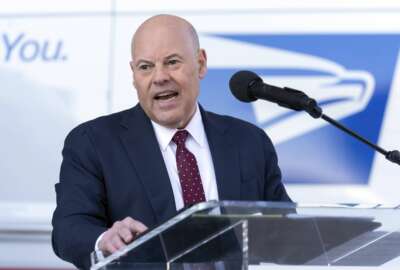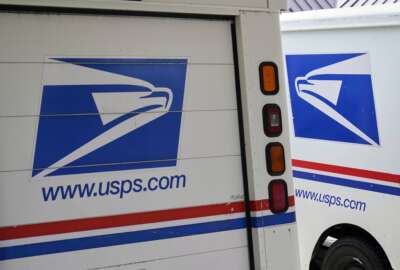USPS sees $2B loss for quarter, but DeJoy says agency’s best days still ‘in the future’
USPS reported a $2.1 billion net loss for the first quarter of fiscal 2024 — more than double its $1 billion net loss for the same period last year.
The Postal Service reported a $2.1 billion net loss for the first quarter of fiscal 2024 — more than double its $1 billion net loss for the same period last year.
The first quarter accounts for the agency’s busy year-end holiday season. USPS ended last year with a $6.5 billion net loss, and expects to end this year with similar results.
Postmaster General Louis DeJoy, however, told the USPS Board of Governors on Thursday that, surveying nationwide changes to the agency’s delivery network, “I grow more confident in our ability to deliver to the nation a Postal Service whose best days are in the future.”
“We are in a race to a finish line that changes our financial and service trajectory before we run out of cash and require other means of funding,” DeJoy said at the meeting.
Despite the first-quarter results, DeJoy focused on USPS growth in its package business — a key feature for revenue growth under the agency’s 10-year reform plan.
USPS, he added, is planning to roll out same-day and next-day shipping offerings “in the near future that will change the way you look at delivery and the way you look at the United States Postal Service.”
USPS saw a $240 million, or 2.7%, increase in package revenue this quarter, and delivered 98 million more packages —a 5.1% increase — compared to the same quarter last year.
USPS delivered a higher volume of packages while cutting 8 million work hours — one of the agency’s largest quarterly reductions in work hours in the last decade, according to Chief Financial Officer Joe Corbett.
“There’s still a lot of work we need to complete to become a long-term, self-sustaining entity,” Corbett said.
USPS saw $21.6 billion in total revenue in the first quarter — a 0.5% increase compared to the same period the year prior.
Meanwhile, the agency saw its total operating expenses grow to $23.8 billion for the quarter, an increase of nearly 5%.
DeJoy and USPS executives attributed the quarterly loss to costs beyond the agency’s control — chief among them, higher inflation and contributions to the Civil Service Retirement System.
USPS argues it’s overpaid into the CSRS fund for decades, and is calling on the Biden administration and Congress for an adjustment in what it pays into the fund.
The Office of Personnel Management is responsible for administering CSRS benefits for USPS employees, and calculates what USPS must contribute every year.
USPS cut transportation costs by about $489 million this quarter, shifting the focus away from air shipping contractors for delivery of mail and packages, moving instead to its ground transportation network of trucks.
“During this peak season, we took necessary operating risks to deliver an increased volume while incurring less costs,” DeJoy said, including minimizing peak season staffing.
USPS only hired 10,000 seasonal employees nationwide for the recent peak season. The agency started to significantly taper its seasonal hiring in 2022, when it brought 20,000 temporary hires on board.
The agency, however, grew its career workforce to 529,000 employees in December 2023. That’s an increase of 11,500 employees, a more than 2% growth in its career ranks, compared to 2022.
Since January 2021, USPS has converted 150,000 employees from pre-career to career status, with better wages and benefits. The agency sees a much lower rate of turnover for its career workforce.
DeJoy said 98% of American households are getting their mail and packages within three days, and that more than half of USPS mail and package products were delivered a day in advance of their service standards.
“I do realize that individual communities do not view our performance at a national level,” he added, noting some delays at the local and regional level.
“Change is never easy, even when it’s for the better. Complications may occur, so we plan to proactively communicate often and early with our employees, customers and relevant stakeholders. To those in the nation that are affected by our intermittent service impacts, we apologize, and we’re working hard to improve our service,” he added.
Looking ahead, DeJoy said USPS is “aggressively” opening Sorting & Delivery Centers across the country, and plans to open 40 new S&DCs later this year.
S&DCs are large facilities that consolidate the operations of letter carriers and mail handlers under one roof.
USPS saw a 2.6% increase in first-class mail, despite a 5.6% decrease in mail volume compared to the same quarter last year. The agency raised mail prices last January and has been setting higher rates for its monopoly mail products each January and July for the past few years.
Copyright © 2024 Federal News Network. All rights reserved. This website is not intended for users located within the European Economic Area.
Jory Heckman is a reporter at Federal News Network covering U.S. Postal Service, IRS, big data and technology issues.
Follow @jheckmanWFED






